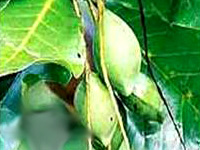Bahada (Terminalia belerica)

Cultivation details :
The tree is a light demander. It can however, withstand slight shade at young age. Young seedlings are known to tolerate heavy shade during the first and second year but heavy shade afterwards kills them. Quite sensitive to frost.
Soil type :
Capable of growing on various types of soils, provided the moisture supply is adequate. Best growth is attained on deep sandy loam soils with good drainage. Sometimes clay loam soil is also suitable for bahada cultivation.
Propagation :
Natural regeneration :
Trees regenerate through seeds and coppice. The tree is a fairly good coppicer, cuttings produced in May- June coppice well. Good seed crops, high germinative capacity of the healthy seeds and the ability of the seedlings to thrive under shade for the first one-year or two are favourable factors for natural regeneration.
Artificial regeneration :
The fruits ripen during November- February. Freshly fallen fruits are collected from the ground, swept clean in advance. The pulp is immediately removed and the seed is sun dried before storing. They retain viability for about a year. For such stored seeds, the germinative capacity is reduced from 40- 50%.
Direct sowing/ transplanting :
The plant can be raised in the field by direct sowing or by transplanting one-year-old nursery raised seedlings. Sowing is done in June- July with the commencement of monsoon rains. The seed is soaked in water for 24 hours to soften the seed coat. Sowing is done in lines about 3m apart. The soil along the lines to be sown is worked well. The seeds are covered lightly.
Planting technique :
Plantation is done in June- July when the plants are about 3-4 months old. Appropriate spacing adopted is 3m X 3m.
Nursery technique :
Sowing in irrigated nurseries is done in the month of March or April. The seed from the current years collection should preferably be used. Lines are spaced about 20 cm and the seed is sown about 5cm. Apart. Germination percentage can be expected of 50-90.
Harvesting techniques :
Collection :
The best time for collection of fruits for the optimum content is the month of January after which the inferior quality of tannin is obtained. Collection done too early also show the similar quality of tannin content.
Harvesting time :
Harvesting is done after 7-8 years of growth. There is no such data regarding harvesting time, till from mid December to mid January is the best time for harvesting (collection).
Processing and storage :
Fruits bored or damaged by insects should be avoided during collection. The fruits are depulped and dried before storing. After deseeding 2 days sun drying is necessary in a dry and ventilated place. In this condition it can be stored for one year. Deseeded Bahada has to be disposed within one year from the processing day otherwise it will lose its valuable properties. Bahada should be packed in dry and clean gunny bags under store in dry place. Under no circumstances it should not be kept at wet place otherwise it will be infected by fungus and discolored.
Grading :
The raw bahada are graded under different trade names. Selection being raised upon their solidness, color and freedom from insect attack. Grading generally consist of separating hallow, infected, damaged nuts from the good quality nuts.
Details of the grading patterns as under.
Trade name |
Grade |
Colour |
General character |
Jabalpur 1 |
J-1 |
Greenish ash colour |
Sound and solid nuts free from insect's attack and broken nuts. |
Genuine Jabalpur |
G.J |
Darkish ash |
Sound and solid nuts free from insect's attack and broken nuts. |
Jabalpur- II |
J-II |
Dark black |
Hallow nuts 25 per cent |
Bhimilics Fin |
BF |
Greenish ash colour |
Sound and solid nuts free from insects attack and broken nuts. |
Bhimilics No-1 |
B-1 |
Blackish |
Sound and solid nuts free from insects attack and broken nuts. |
Bhimilics average |
BA |
Blackish |
2 per cent foreign matters 30 per cent hallow nuts and 10 per cent broken nuts |
Rajpore No-1 |
R1 |
Brownish black |
Foreign matters 6 %, decayed and hallow nuts shall not exceed 15 % |
Vingloras |
V-S |
Black |
Decayed and hallow nuts shall not exceed 30 % |
Yield :
No data seem to have been collected regarding the yield of myrobalan as nowhere collection is done in an organized manner and the distribution is scattered and so the yield per hectare could also not be ascertained.
Economics :
No data seem to have available regarding the economics of bahada.
Source :
- Cultivation of medicinal plants by Dr. C.K.Kokate, Dr. A.S.Gokhle and Prof. S.B.Gokhle
- Production technology of medicinal and aromatic crops by Dr. A.A.Farooqi, Dr. M.M.Khan and Dr. M.Vasundhara.
|

